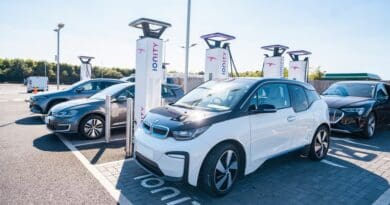
Electric Vehicle Charging Trends in the UK – 2024 and Beyond
I’m sure you’re not the only one who has noticed the surge in Electric vehicles on the road in the UK. It seems like there is at least one Tesla on every street at this point.
As of 2023, more than half a million EVs now share the roads, with a rapidly growing need for accessible and efficient charging infrastructure. This shift isn’t only affecting residential areas; it’s also influencing commercial spaces, workplaces, and public hubs.
In this article, the commercial EV Charging experts Electrassure share their expertise and real-life views into the latest EV charging trends in the UK for 2024 and beyond. They will be covering everything from infrastructure growth and future innovations to changing consumer perspectives and government policies. Whether you’re an EV owner, a business manager, or simply interested in the future of sustainable transport, this guide will plug you into the latest developments and what to expect as EV charging trends evolve.
Growth Statistics in EV Charging Infrastructure in the UK
UK charging infrastructure is rapidly expanding to try and meet the demand. The past few years have seen significant investment from both the government and private sectors, aiming to support EV drivers with reliable and convenient charging solutions.
Recent Growth in EV Charging Points
In 2023, the UK surpassed a milestone with over 40,000 public EV charging points available nationwide, a significant increase compared to just a few years prior. This growth includes various charging types, from standard 7kW chargers in residential areas to ultra-rapid 150kW+ chargers at motorway services. Companies such as BP Pulse, Shell Recharge, and Gridserve are at the forefront, expanding their charging networks to ensure accessibility for EV owners across urban centres and travel corridors.
This surge in public charging options has been essential for alleviating “range anxiety,” a common concern among prospective EV buyers. Rapid and ultra-rapid chargers are becoming more prevalent, allowing drivers to recharge their vehicles to 80% capacity in less than 30 minutes—making EV travel increasingly convenient and efficient.
Annual Growth Rate and Projections
Between 2018 and 2023, the UK’s EV charging network experienced a compound annual growth rate (CAGR) of over 30%, reflecting both consumer demand and regulatory support. Projections for the next five years indicate that this trend will continue, with an estimated 150,000 charging points anticipated by 2030. This includes not only public chargers but also residential charging points, which are expected to become increasingly common as EV ownership rises.
However, there are notable regional differences. Cities like London have seen rapid development of charging infrastructure due to higher EV ownership rates and local government initiatives, while some rural areas have yet to catch up. Addressing these disparities will be key to achieving the UK’s EV adoption goals and ensuring that all drivers have equitable access to charging facilities.
Projected Growth and Future Trends for EV Charging in the UK
The attitude to theUK’s EV charging landscape is progressing to say the least, as innovations in technology and consumer preferences shape the future. Projections for the next decade suggest that charging infrastructure will become more widespread, smarter, and faster. Here’s what to expect in the coming years:
Residential Charging Trends
As EV ownership becomes more mainstream, home charging solutions are on the rise. Many drivers are choosing to install private chargers, which allow for overnight charging and lower costs compared to public alternatives. A trend that’s likely to gain momentum is bi-directional charging, also known as vehicle-to-grid (V2G) technology. This allows EV owners to sell unused energy back to the grid, promoting energy efficiency and providing an extra income stream for users.
To encourage these installations, the UK government continues to offer grants and incentives, like the Electric Vehicle Homecharge Scheme (EVHS), which reduces the cost of home charger installations. As more households adopt EVs, these incentives are expected to evolve, potentially supporting features like smart energy management, which enables users to charge their vehicles during off-peak hours.
Commercial Fleet Charging Trends
Commercial sectors, particularly those operating large fleets, are embracing EVs to cut costs, reduce emissions, and comply with environmental regulations. To support this shift, companies are investing in workplace and fleet charging stations, often opting for fast charging and ultrafast charging solutions that ensure vehicles are ready for daily operations.
Emerging technologies in this space include integrated charging management software, which helps businesses monitor energy use, schedule charging sessions, and optimise costs. As the commercial fleet market grows, so too will the demand for scalable, efficient charging infrastructure that can accommodate larger numbers of vehicles.
Commercial operators can also enforce their parking lots with highly‑accurate ALPR software, ensuring only authorised EVs use charging facilities and improving site security.
Innovations in Public Charging Networks
Public charging is undergoing a transformation with the rise of ultra-rapid chargers and charging hubs in cities and along motorways. Chargers with capacities of 150 kW and above are being installed at motorway services and urban centres, allowing drivers to recharge quickly and conveniently.
To enhance user experience, many providers are adopting subscription-based models and pay-as-you-go options, as well as apps that offer real-time information on station availability, pricing, and payment options. These developments cater to the growing expectations of EV drivers for reliable, fast, and user-friendly charging solutions.
Changing Consumer Perspectives on EV Charging
As the electric vehicle market expands, UK consumers’ attitudes towards EVs and charging options are shifting. A deeper understanding of these changes offers insight into what drivers are looking for in an EV charging experience.
Increased Acceptance and Interest in EVs
The lower running costs and environmental benefits of EVs are attracting more UK residents, with surveys showing that more than half of potential car buyers are considering an EV for their next vehicle purchase. This shift is driven by the younger generation, urban residents, and environmentally-conscious individuals who are motivated by sustainability and a reduced carbon footprint.
With the government’s 2030 petrol and diesel ban on the horizon, public sentiment is increasingly positive. Many consumers see EVs not just as a practical choice but as a contribution to the UK’s clean energy future. This trend suggests that as infrastructure improves, so will the adoption rate, as EVs become the default for those seeking affordable, eco-friendly transport.
Consumer Expectations for Charging Availability and Speed
EV owners are seeking faster and more accessible charging options, particularly in locations they frequent, such as supermarkets, shopping centres, and workplaces. As a result, businesses and public places are expanding their charging facilities to attract EV drivers and meet their needs for convenient, reliable charging.
With more EVs on the road, drivers are also becoming accustomed to faster charging times. Ultra-rapid chargers that provide an 80% charge in less than 30 minutes are highly favoured, especially for long journeys or trips where a quick turnaround is essential. In fact, speed and availability are now seen as essential components of a positive EV ownership experience.
Sustainability Concerns and Interest in Renewable Energy
Today’s consumers are increasingly focused on the source of their charging power. There is growing demand for renewable energy-based charging solutions, particularly in residential settings where EV owners can choose solar or wind power sources. This trend has led to the development of solar-powered EV charging stations that allow users to harness clean energy, reducing their carbon footprint even further.
This shift towards sustainability highlights a broader change in consumer values, where reducing emissions and prioritising renewable energy are just as important as convenience and cost. As this trend continues, the demand for eco-friendly charging solutions will likely drive further innovation in the sector.
Government Policies and Regulations Influencing EV Charging in the UK
The UK government has implemented a series of policies and initiatives aimed at facilitating the growth of EV infrastructure and promoting widespread EV adoption. These efforts are intended to make EVs accessible to everyone, regardless of where they live or their income level, and to address environmental concerns tied to fossil fuel emissions.
Government Support and Funding
One of the primary drivers behind the UK’s EV charging expansion is government funding. Programs like the Electric Vehicle Homecharge Scheme (EVHS) offer grants to cover a portion of the cost for residential charging installations. This incentive encourages more households to install private chargers, supporting those who may not have easy access to public charging points.
For businesses, the Workplace Charging Scheme (WCS) provides similar grants to support the installation of on-site charging stations. This program is particularly valuable for companies transitioning their fleets to electric vehicles, as it helps offset the costs of installing necessary infrastructure. In addition, funding from the government has been directed toward ultrafast charging networks along key travel routes, allowing drivers to confidently travel long distances without worrying about charging availability.
Regulatory Shifts in EV Charging Standards
The UK government has also implemented new regulations to improve the user experience and ensure consistent standards across the charging network. Public charging stations are now required to offer contactless payment options, making them accessible to all users without the need for specific apps or membership cards. This regulation aims to streamline the charging process and make it as simple as filling up at a petrol station.
Furthermore, there is a growing emphasis on universal access and inclusive design for public chargers, ensuring that stations are accessible to people with disabilities. These regulations reflect the government’s commitment to making EV adoption practical for everyone, regardless of physical ability or technological preference.
As the UK progresses towards its 2030 goal, we can expect further regulatory developments to shape the EV charging landscape, focusing on accessibility, standardisation, and sustainability. This continued support will be essential for helping consumers and businesses alike transition smoothly to electric transportation.
Challenges and Barriers to EV Charging Expansion
Despite significant progress, several challenges still stand in the way of a fully developed and equitable EV charging infrastructure in the UK. Addressing these barriers will be crucial for the UK to meet its EV adoption targets and facilitate a seamless transition away from fossil-fuel-powered vehicles.
Infrastructure and Grid Challenges
The UK’s national grid faces substantial challenges in supporting a rapid increase in EV charging demand. Ultrafast chargers and large-scale commercial charging stations require significant power, placing strain on the existing electrical grid. This demand has sparked discussions about grid upgrades, energy storage solutions, and smart charging technologies that can balance demand during peak times. However, the high installation costs associated with these upgrades are a barrier, especially for rural areas and small businesses.
Another consideration is ongoing maintenance and equipment upgrades for existing charging stations, which can be costly and time-intensive. As more EVs hit the road, ensuring that chargers remain in good working order and meet the latest standards will be critical to maintaining consumer confidence in the network.
Geographic Disparities in Charging Availability
The UK faces an urban-rural divide in EV charging access. While major cities like London have abundant charging points, rural and remote areas lag behind. This disparity limits EV ownership options for people living outside urban centres and may deter potential EV buyers concerned about access.
To address this gap, there are proposals for government-led initiatives aimed at subsidising charging stations in underserved areas, potentially using a combination of public and private funding. Solving this issue will require collaboration between local councils, private companies, and policymakers to ensure that rural areas benefit from the same EV charging advancements seen in cities.
The Role of Innovation in Shaping the Future of EV Charging in the UK
Innovation continues to play a transformative role in the evolution of EV charging, with new technologies and approaches emerging to address current challenges and anticipate future needs. These advancements are reshaping how, where, and when EV drivers charge their vehicles.
Wireless and Mobile Charging Solutions
One of the most exciting developments in EV charging is wireless charging. By utilising magnetic induction, EVs can be charged by simply parking over a charging pad, eliminating the need for physical plugs and cables. Although this technology is still in its early stages, it has the potential to make charging more convenient, especially in urban environments where space is limited.
Additionally, mobile charging units are gaining popularity as a flexible solution for EV drivers. These units bring the charger to the vehicle, allowing users to charge their EVs on-demand without needing to locate a charging station. This model is particularly useful for emergency situations or for drivers who lack easy access to fixed chargers.
Integrating Smart Charging and IoT
The integration of smart charging and Internet of Things (IoT) technology is reshaping the way EV charging is managed and optimised. Smart charging enables drivers to schedule their charging sessions during off-peak hours, reducing costs and helping to balance grid demand. These technologies also provide real-time data on charging station status, availability, and usage, allowing for better resource management and improved user experience.
Moreover, the potential of vehicle-to-everything (V2X) technology means that EVs could one day communicate with homes, businesses, and charging stations, facilitating a fully integrated energy ecosystem. This connectivity can support broader sustainability goals by enabling vehicles to feed power back into the grid during peak demand, effectively turning EVs into mobile energy storage units.
Plug into the Future of EV Charging with [Your Company’s Name]
The electric vehicle revolution is here, and the future of EV charging in the UK promises to be faster, smarter, and more accessible than ever. Whether you’re a new EV owner, a business leader with a growing fleet, or someone interested in the sustainable transport movement, staying informed about these trends is essential.
This article was written by EV exert Thomas Jones from ElectrAssure. They are open to talking more to commercial fleet owners on how they can transition their fleet infrastructure to electric.





